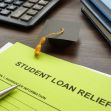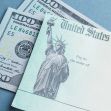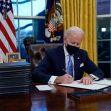President Biden quickly got to work on his first day in office by signing a slew of executive orders. Some of them were new while others worked to reverse policies put in place by President Trump. One such executive order tackles the mounting student loan crisis in the nation.
During the pandemic, there was an interest-free moratorium on federal student loan payments that allowed borrowers to refrain from making payments without having interest accrue on their account. In his executive order, Biden has asked the Department of Education to keep the moratorium in place at least until the end of September in hopes of alleviating some of the burden caused by the pandemic.
Biden officials shared in a statement, "Borrowers of all ages are often faced with a tough tradeoff between making their student loan payments, investing in their long-term financial future, or paying their bills. The pandemic has only increased the economic hardship of the millions of Americans who have student debt."
Biden Administration Tackles Student Loan Crisis
Extending the federal moratorium on student debt relief is the first step in Biden's campaign promise to finding a solution to the national student debt crisis. Adults who carry a federal student debt owe a collective $1.5 trillion. It is estimated that the average American owes just under $29,000 in student loan debt. This does not include the estimated $119 billion in student loans that are borrowed from private industries.
As part of his campaign strategy, Biden campaigned heavily on tackling the burden of federal student loan debt. Biden is still on track with his mission to cancel out $10,000 for student loan borrowers as part of COVID-19 relief. However, this measure needs to pass Congress first before Americans can reap the benefits. Even if Biden's proposal does pass Congress, the legislation will have likely changed in some form or another. And while a $10,000 break may be helpful, it will still only be a dent for many students as it is estimated that roughly 67% of borrowers have more than $10,000 of student debt under their name.
Biden Administration Revamps Current Federal Student Loan Program
While all the finer details are still being worked out, Biden's student loan relief plan is targeted toward those who attended a public college or university, those who use loans toward undergraduate tuition, and finally those who earn less than $125,000 a year.
In addition to his broad revamping of the Federal Student Loan Program, Biden also wants to revamp the current income-driven repayment plan. Presently, borrowers can set options between 10% and 20% of their discretionary income automatically going toward their student loan repayment. Under Biden's plan, this percentage would be lowered to 5%. Depending on a borrower's repayment plan, the remaining balance will be forgiven once the income-driven repayment plan is fulfilled after 20 or 25 years.
Under the current plan, the remaining forgiven balance is then a balance that you get taxed on at the end of the year. Under Biden's new plan, the remaining balance will be tax-free. Additionally, Biden's plan will allow for a payment of $0 if your income is lower than $25,000.
Biden Pushes for More Government Grants
The Biden administration is also pushing for larger Pell Grant distributions. Instead of the current maximum of just under $7,000, Biden would like to double this amount to help students cover additional expenses including room and board, transportation, books, and sometimes even tuition as it can go over $7,000.
Biden's plan will also include additional funding for the Public Service Loan Forgiveness Program. This program allows public servants including teachers, government workers, and nonprofit employees, to make payments for 10 years before they will be able to have their remaining balance forgiving.
Even more optimistic is Biden's push for free college tuition. Under this aspect of tackling the student loan crisis, Biden campaigned on the hope of free tuition if you attend a public college or university, if you attended a private university that serves minorities, or if you attend a community college.
While the Biden administration has starting paving a hopeful path to help alleviate the burden of student loan debt, it remains unclear what that path will look like.
Both Democrats and Republicans agree that there is an issue with student loan debt, but unlike Democrats who want to completely wipe away federal student loan debts and then restructure the program, Republicans are calling for the program to be restructured first so as to lay the groundworks for a successful program.






